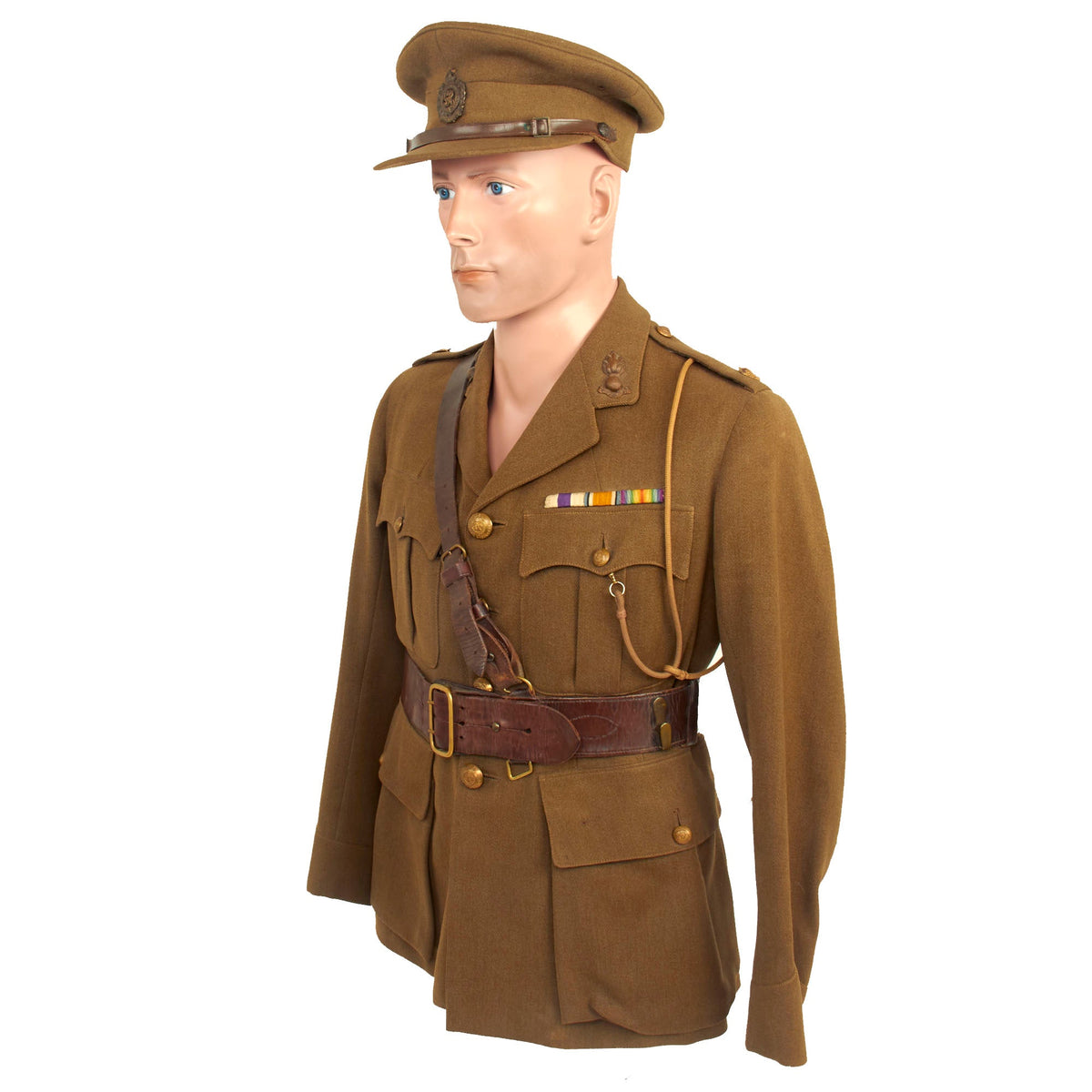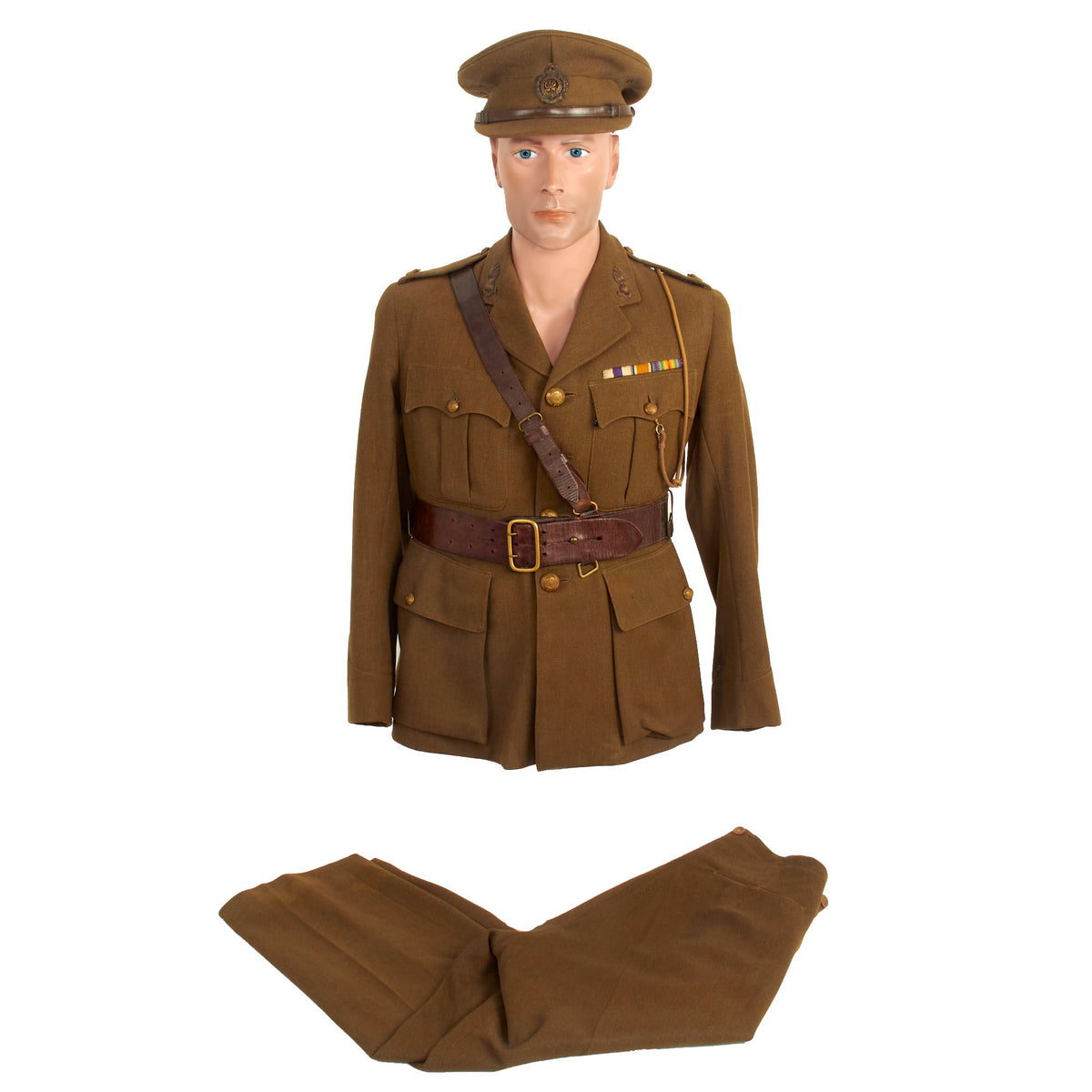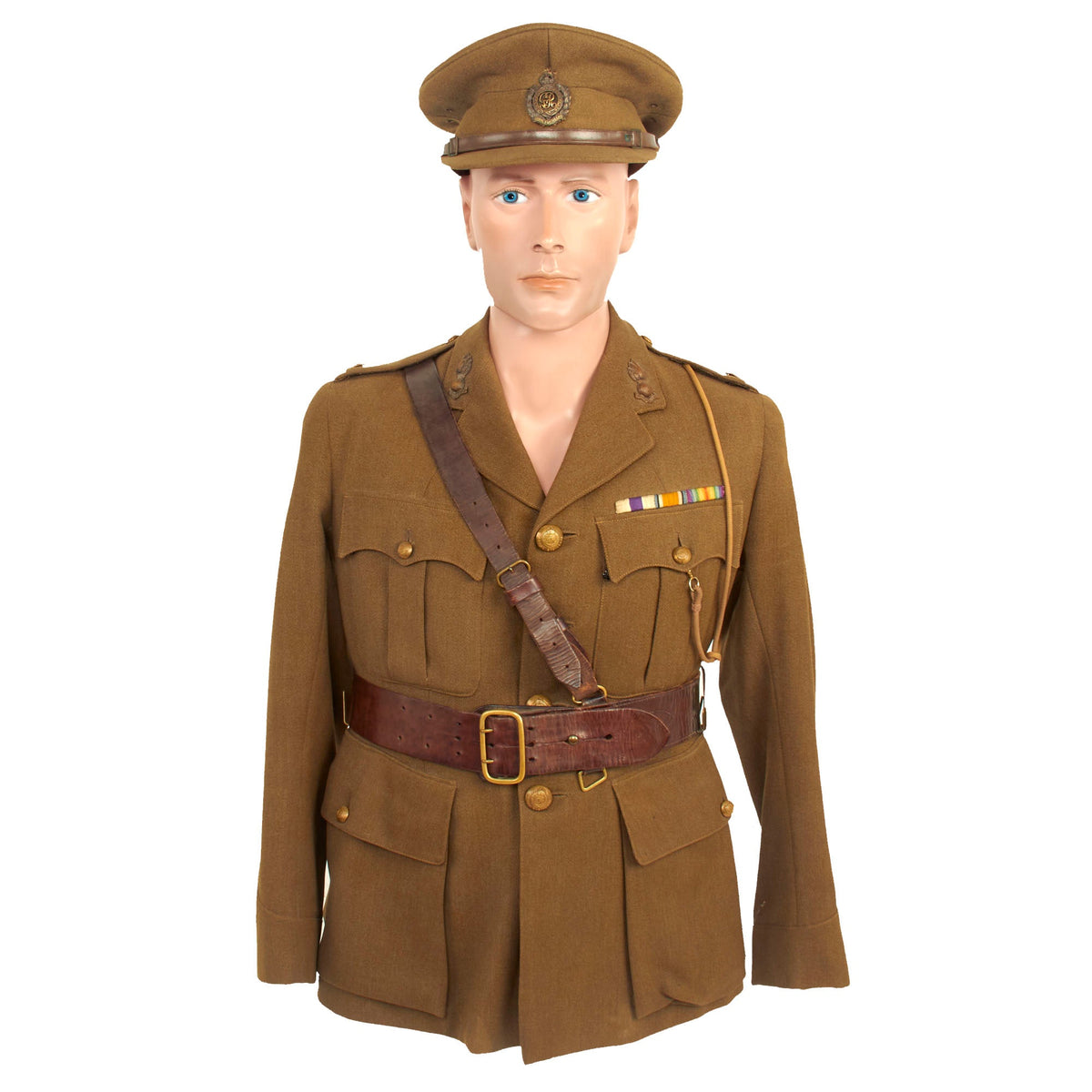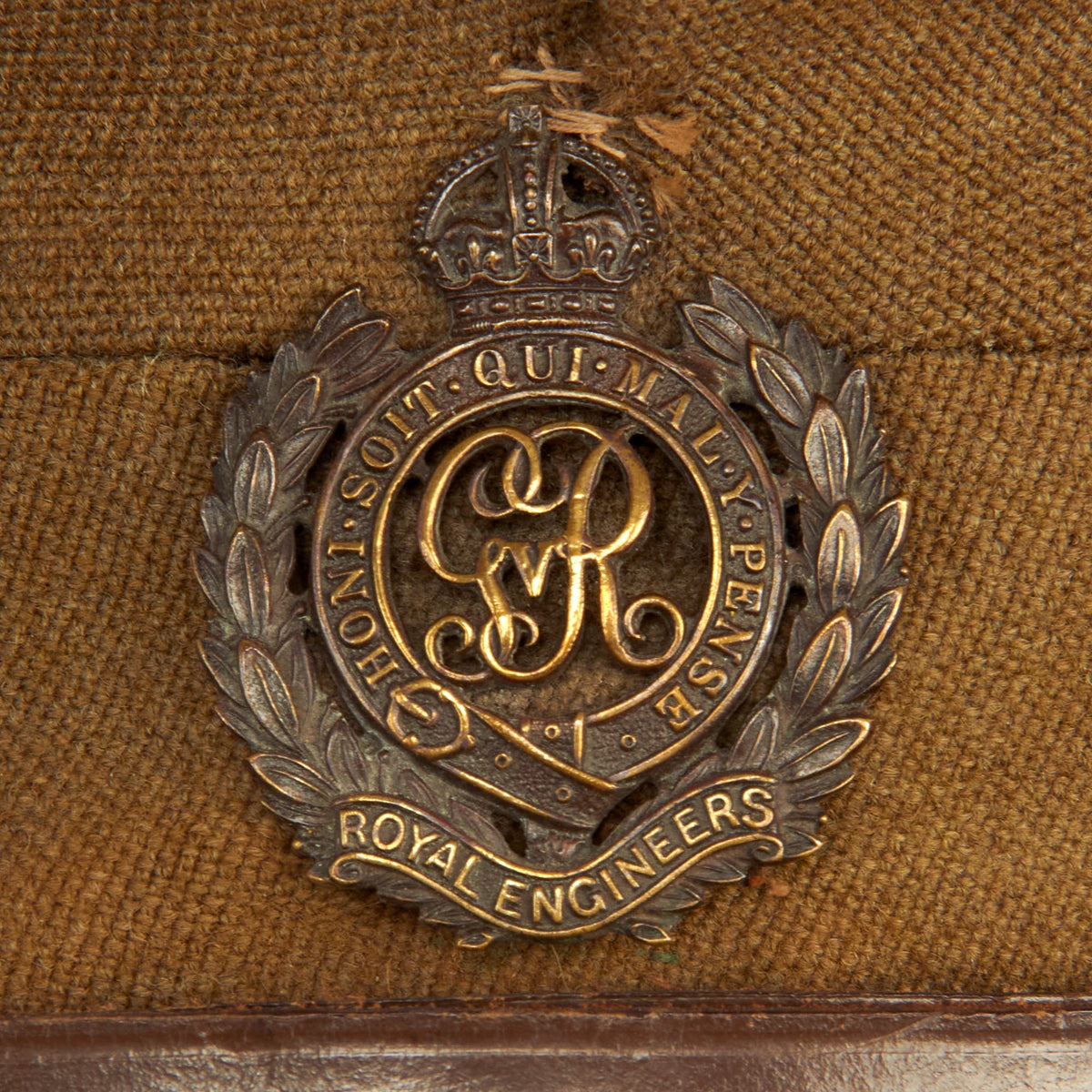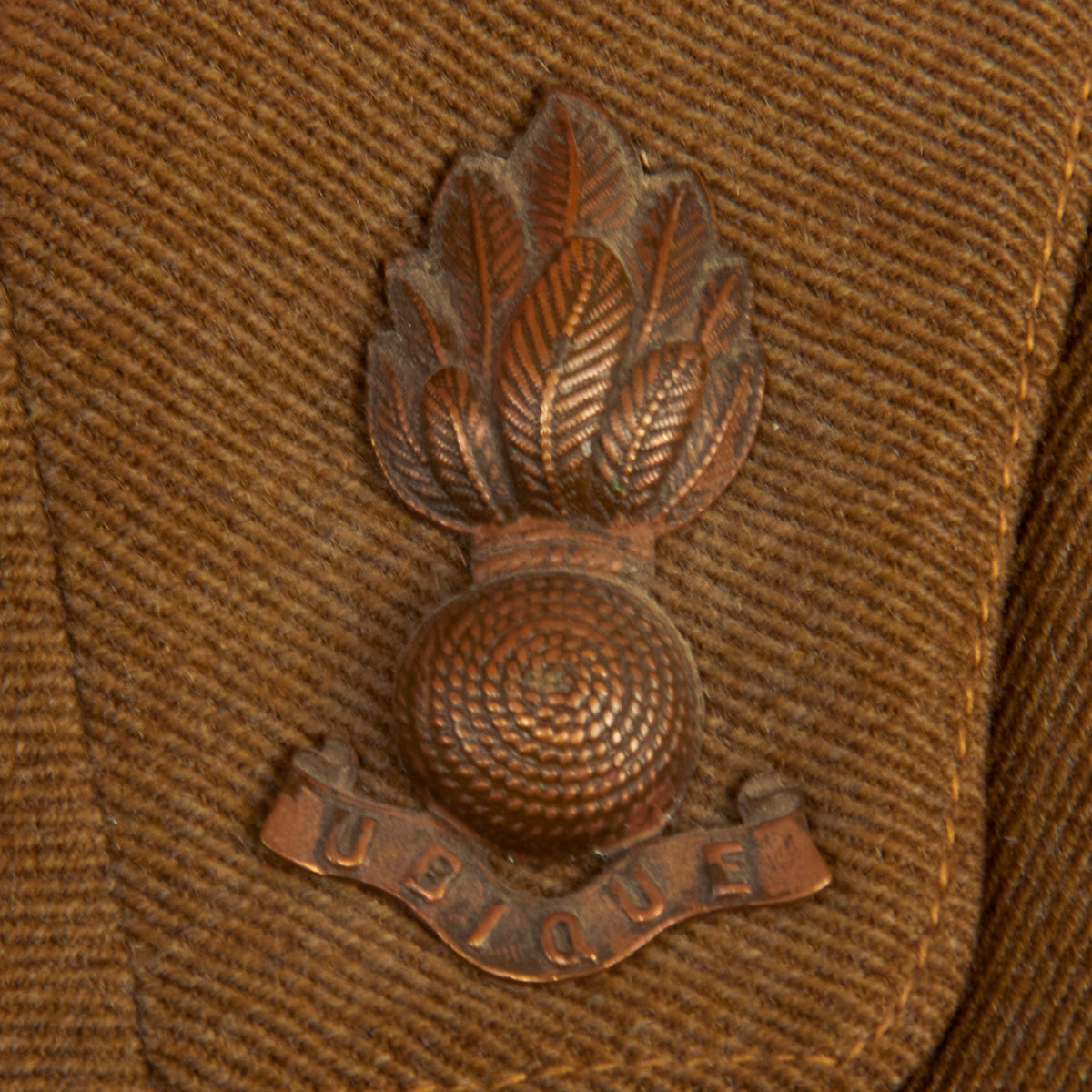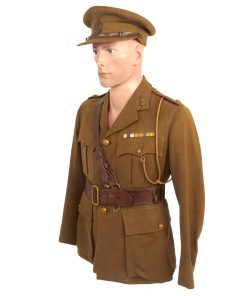Original British WWI Royal Engineers Named Officer’s Uniform Set with Visor Cap For Military Cross Recipient “Major Thomas” Original Items
$ 995,00 $ 248,75
Original Item: Only One Set Available. Now this is an absolutely lovely uniform set! This uniform was worn by an Officer of the Royal Engineers during WWI, an Officer who was awarded the Military Cross, the third-level (second-level pre-1993) military decoration awarded to officers and (since 1993) other ranks of the British Armed Forces, and formerly awarded to officers of other Commonwealth countries. This medal was awarded for “gallantry during active operations against the enemy”. Unfortunately, all we have is his name and what appears to be a possible service number, perfect starting points for research.
In January 1902, the British army adopted a universal khaki uniform for home service wear, the Service Dress, after experience with lighter khaki drill in India and South Africa. The traditional scarlet, blue and green uniforms were retained for full dress and off duty “walking out dress” wear. Details of these colorful uniforms varied greatly between regiments and branches of the army. The early use of camouflage in the form of plain khaki reflected the exigencies of colonial war and the freedom allowed, and taken, by many of the officers who fought it. The adoption of khaki for active service resulted from the development of weapons of greater accuracy and range combined with smokeless powder during the late 19th century, making low-visibility on the battlefield a matter of priority.
This lovely khaki uniform is in absolutely fantastic condition for the age. It features a worn, yet supple Sam Browne belt which still attaches properly to itself and the integrated hooks on the jacket itself. The shoulder straps each have a single crown device denoting the rank of Major in the British Army. Before 1917, the Military Cross when created for commissioned officers of the substantive rank of captain or below and for warrant officers. In June 1917, eligibility was extended to temporary majors, not above the substantive rank of captain. Substantive majors were made eligible in 1953. So Major Thomas was most likely a Temporary Major when he was awarded the MC. Temporary ranks were usually granted for a specific task or mission. The holder holds the rank while occupying that position. Despite the name, temporary rank may be held for a considerable period of time, perhaps even years. In wartime, temporary ranks are often common.
Each collar has a lovely “UBIQUE” grenade for the Royal Engineers. The grenade first appeared on Royal Engineers uniform in 1824 when it was worn on the tail of an Officer’s full dress coatee. In 1825 a brass grenade was introduced for other ranks of the Royal Sappers and Miners. Later the grenade came to be worn on the epaulet and then the collar. In 1922 the ‘9 flamed’ grenade was authorized (whilst the Royal Artillery grenade only has 7). These devices are “9 Flamed” meaning he could very well have worn this uniform and stayed in the Army after WWI, which was not uncommon for Officers, meaning again, he could have received his MC as either a Lieutenant or a Captain, another great research opportunity to help narrow down the search.
All “GvR” monogram Royal Engineers buttons are present and intact. British army regimental and corps tunic buttons are as varied as all other aspects of regimental insignia. They come in 3 main sizes with c. 26mm “Large” size used for tunic buttons, great coats and officer’s buttons. The c. 19mm “Medium” sized buttons used for No. 2 Khaki service dress tunic buttons, parade uniforms, pockets and epaulets. The c. 14mm “Small” size buttons mainly used for caps, mess dress waistcoats and General’s red insignia gorget tabs.
The lining is in wonderful condition and does show signs of wear without any extensive damage. The interior lining in the top back still retains a lovely tailor’s tag for:
J. C. SMITH LTD
EDINBURGH & ST. ANDREWS
12.045
MAJOR THOMAS
The trousers are in similar, wonderful condition and are also marked on the inside with MAJOR THOMAS. The peaked visor is in wonderful condition, a little misshapen but if presented without any extensive damage. The top celluloid cover is worn and aged, but fortunately the manufacturer’s information is still somewhat visible:
BY APPOINTMENT
SCOTT & CO
HATTERS TO H. M. THE KING
THE ROYAL FAMILY
1 OLD BOND STREET
PICCADILLY. W.
This is a wonderful uniform set and an even better research opportunity.
Approximate Measurements
Collar to shoulder: 9″
Shoulder to sleeve: 25”
Shoulder to shoulder: 15.5”
Chest width: 18″
Waist width: 15″
Hip width: 21”
Front length: 29″
Pants:
Waist: 16″
Inseam: 26.5″
Fast Shipping with Professional Packaging
Thanks to our longstanding association with UPS FedEx DHL, and other major international carriers, we are able to provide a range of shipping options. Our warehouse staff is expertly trained and will wrap your products according to our exact and precise specifications. Prior to shipping, your goods will be thoroughly examined and securely secured. We ship to thousands clients each day across multiple countries. This shows how we're dedicated to be the largest retailer on the internet. Warehouses and distribution centres can be located throughout Europe as well as the USA.
Note: Orders with more than one item will be assigned a processing date depending on the item.
Before shipping before shipping, we'll conduct a thorough inspection of the items you have ordered. Today, the majority of orders will be delivered within 48 hours. The delivery time will be between 3-7 days.
Returns
The stock is dynamic and we cannot completely manage it because multiple stakeholders are involved, including our factory and warehouse. So the actual stock may alter at any time. It's possible that you may not receive your order once the order has been made.
Our policy is valid for a period of 30 days. If you don't receive the product within 30 days, we are not able to issue a refund or an exchange.
You can only return an item if it is unused and in the same state as the day you received it. You must have the item in its original packaging.
Related products
Uncategorized
Uncategorized
Armored Burgonet Helmet & Polearm from Scottish Castle Leith Hall Circa 1700 Original Items
Uncategorized
Uncategorized
Uncategorized
Uncategorized
Uncategorized
Uncategorized
Band of Brothers ORIGINAL GERMAN WWII Le. F.H. 18 10.5cm ARTILLERY PIECE Original Items
Uncategorized
Uncategorized
Uncategorized
Uncategorized
Uncategorized
Uncategorized
Armoured Fighting Vehicles of the World: AFVs of World War One (Hardcover Book) New Made Items
Uncategorized
Uncategorized
Uncategorized
Uncategorized
Uncategorized
